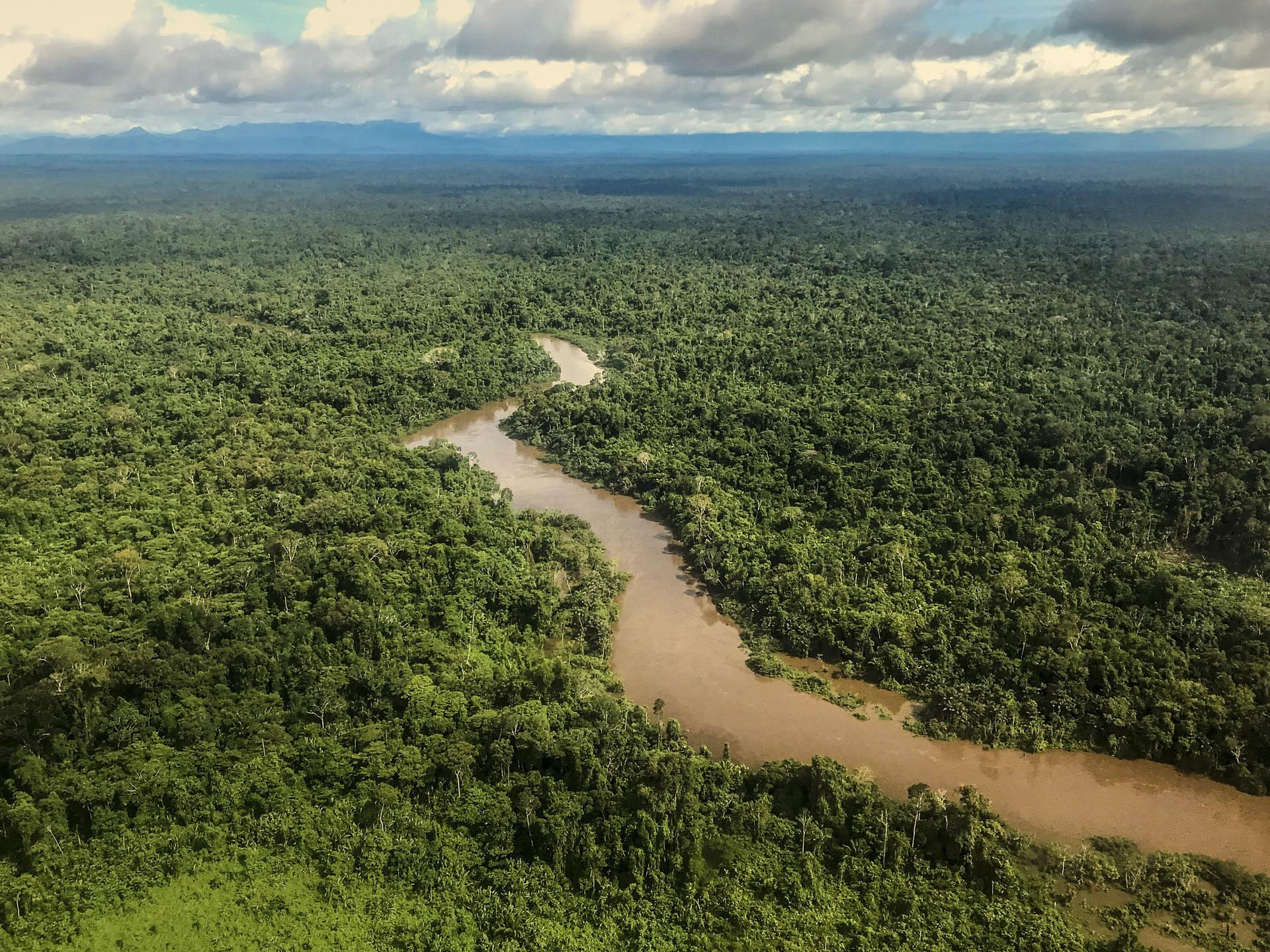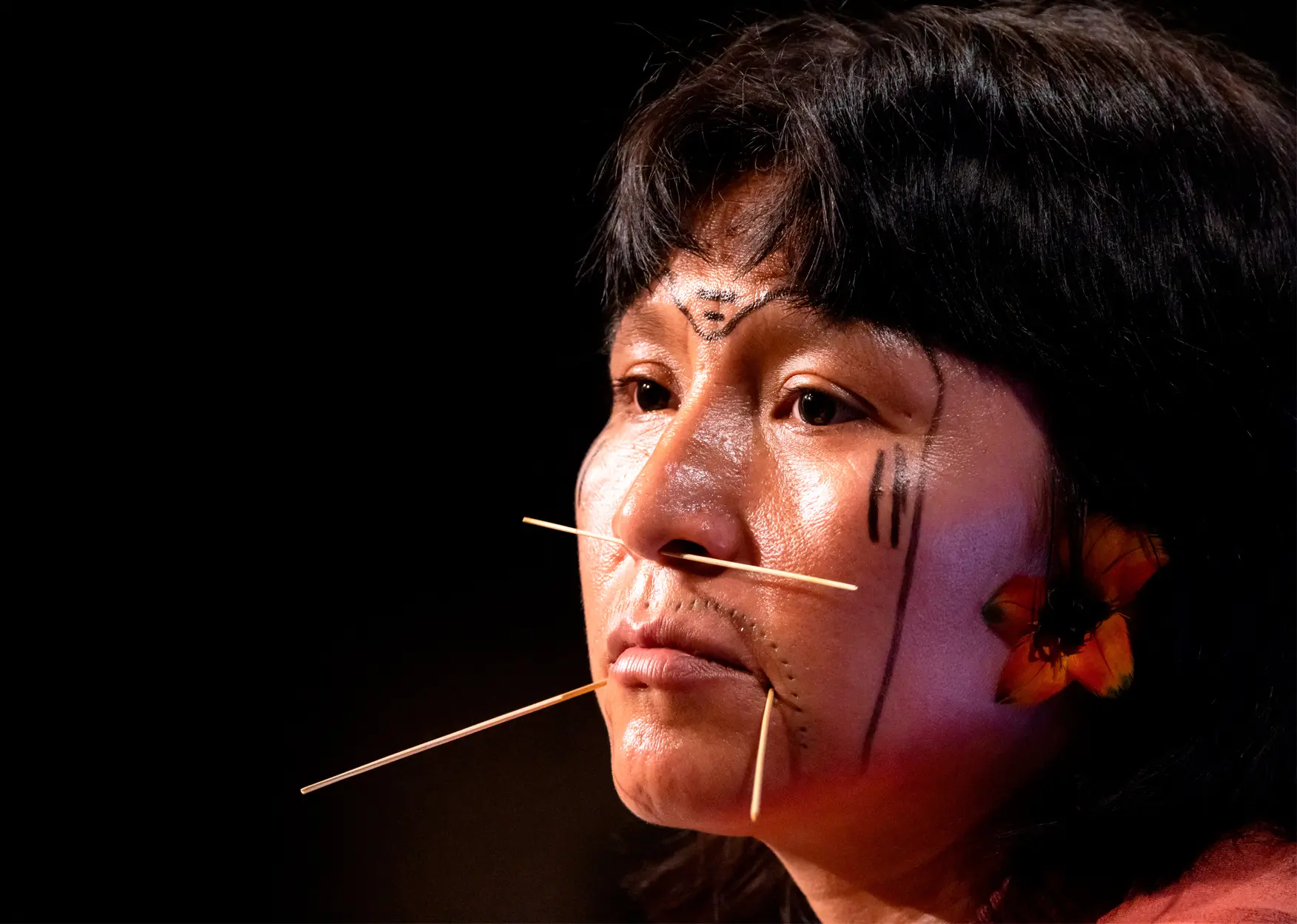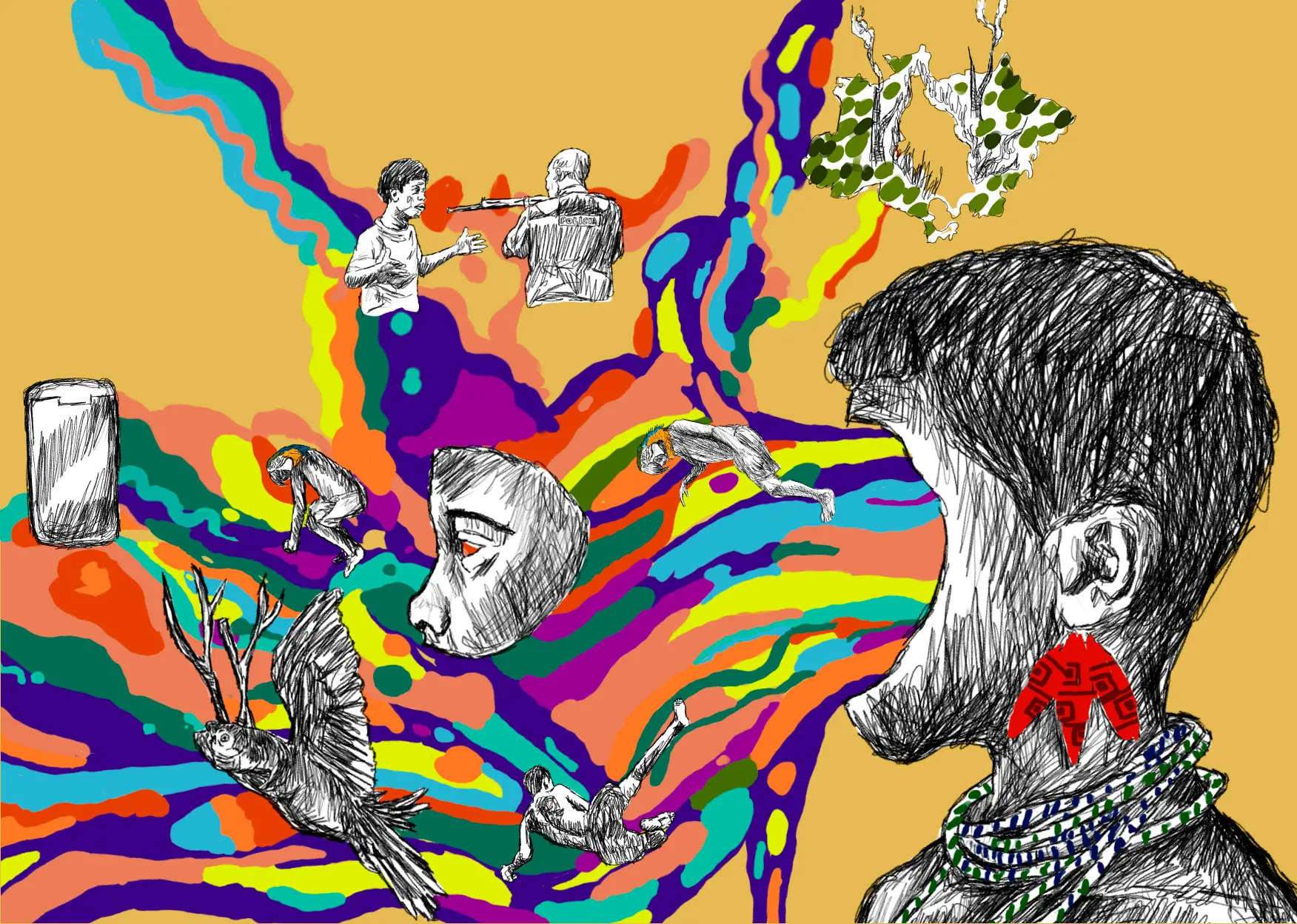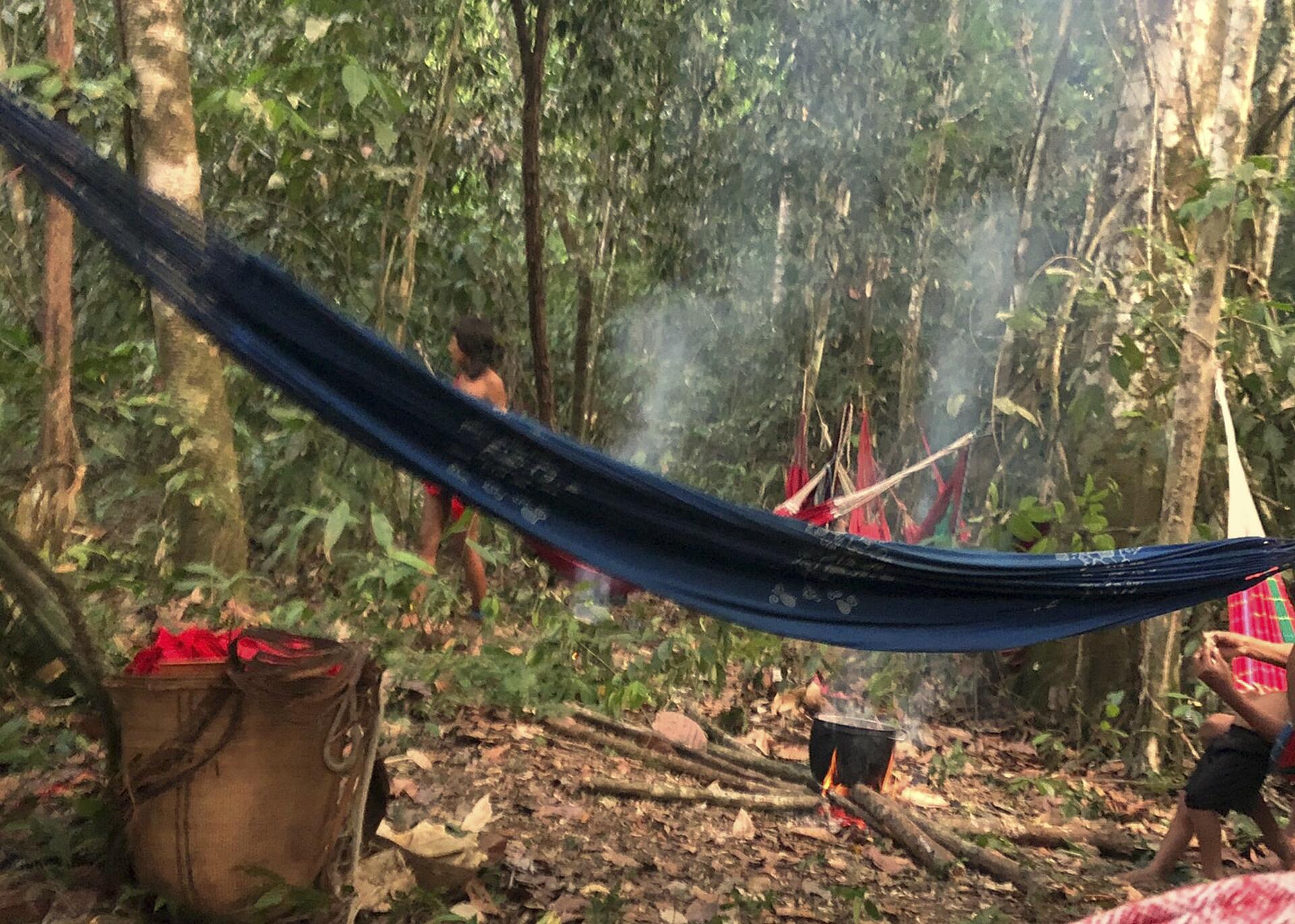The Demini River runs through the central part of the Yanomami Indigenous Land. Its source lies at the foot of the mountains that rise near the border of Brazil and Venezuela. The river descends slowly, curving around the Aracá mountain range until it flows into the Negro River near the municipality of Barcelos, in the State of Amazonas. Its curves and rapids form the route of the Yanomami who travel to the town to access cash transfer programs like Bolsa Família. The Maxokapiu community is located in the channel of the Demini and it was there that I was able to live with the Yanomami for many months, over the course of various trips between 2018 and the present, and get up a close-up view of the ongoing impact of Bolsa Família and other government programs on the forest floor. Contrary to the positive results achieved by cash transfer programs in the country’s different regions, the way it was thought out and how it actually reaches the Yanomami and many other indigenous peoples in Brazil, this experience made me concerned the Bolsa Família program could create more problems than solutions.
From Maxokapiu to Barcelos is a four-day journey, cruising down the river and sleeping in the forest. Entire families travel in the small jam-packed aluminum boats. Mothers with their babies go to receive the Bolsa Família and the Auxílio Maternidade (Maternity Allowance). Grandfathers and grandmothers go to draw out their pensions. Men, adults and teenagers – husbands, sons, brothers and brothers-in-law – pilot the boats and take responsibility for sorting out food whilst on the trip. Most of the time, they are the ones who know a little bit of Portuguese and they go along with the others to help in the dealings with the napë pë (non-indigenous people). Hitching rides on the few boats available, other relatives who live in the same and neighboring communities follow along, all with the same purposes in mind. Many of them, already adults, told me this would be their first visit to the “city”. Or, as they say, their first visit to napëpë urihi, the “land/forest” of the whites.
In this area of the Yanomami Indigenous Land, government cash transfer programs are now the main source of incoming matihipë – the term the Yanomami use for goods from non-indigenous people. In the past, the most desired goods were metal tools, such as machetes and axes. A number of trails in the forest connected people from distant communities, creating extensive exchange networks through which these objects circulated, worn out by years of use. These tools replaced those made of stone and wood, which had a direct effect on the expansion of the Yanomami’s productive capacity.
In the 1950s, during the first years of systematic contact with non-indigenous people, there was an increase in the quantity and diversity of matihipë: clothes, wool, fabrics, cotton hammocks, matches, aluminum pots, firearms, ammunition, flashlights, batteries, and beads were distributed to the indigenous people under a classic “pacification” model – and also as a form of payment for services rendered by the Yanomami on the different contact fronts. This model of access to goods lasted for decades and promoted the successive approximation and the settling of indigenous people in regions near the contact points with the napë pë in the forest.
Over the years, the search for matihipë as well as for health services fueled migrations that resulted in many communities moving to the banks of the Demini River, from where they began to access the markets in Barcelos directly. They brought some forest products to sell: nuts, different types of vines, meat, animal hides, and the baskets they produced. With the funds they were able to raise, they made their first purchases. The Yanomami then began to discover the infinite range of goods produced and sold by the napë pë, gaining interest in them as they gained a certain degree of autonomy to choose what they wanted.
Over the years, things like watches, laces, cell phones, speakers, batteries, solar panels, cups, plates, soccer boots, soccer balls, and food products have become part of the landscape of these communities. The Yanomami were traveling to the city more frequently than they used to, but the trips were still at irregular intervals. It was in this context that in the 2010s, at the end of Luiz Inácio Lula da Silva’s second term in office, the Bolsa Família (the Federal Government’s family allowance program) and other cash transfer programs were introduced in the indigenous land.
At this point it became part of the routine of Yanomami families to embark on a long journey that started off in the rivers they knew and ended in the unknown ordeal of city bureaucracy. Right from the start, nothing about this journey is easy. On clear days, the heat is excessive and the sun burns. On rainy days, the wind and cold punish the wet bodies inside the open boats. During the journey from the Demini River to Barcelos, hunger is overcome with beiju (tapioca pancakes) and flour prepared beforehand and with whatever they can find in the forest: fruit, fish, and game that the Yanomami come across on their paths. The small “rabeta” (rear-mounted) engines propel the boats along the winding trail to the town and their noise rips through the forest. In the dry season, the engines and boats have to be dragged over the rocks in the riverbed. Everything becomes even harder and slower.
Upon arriving in Barcelos, the journey’s challenges take on a new form. The Yanomami have to continue navigating, but now it is in offices where they face loads of red tape in order to get all the necessary documents: the RANI (Indigenous Birth Registration) and, based on it, birth certificate, identity card, CPF (Individual Taxpayer Registration Number), etc… Once they have got all the paperwork in their hands, they can register in the program and finally try to open an account at the Caixa Econômica Federal (Brazil’s Federal Savings and Loans Bank). After having crossed an entire forest, these are often the real barriers for many of them, especially those who have no command of the Portuguese language and little or no training in the world of letters and numbers.
While they are facing these hurdles, they have to survive in the city. Unlike the hospitality of the vastness of the forest, in the small urban area of Barcelos there are not many options in terms of places to sleep. When the rivers recede, the Yanomami set up improvised camps on the islands that form in the middle of the Rio Negro, near the city. But during the flood season, the islands disappear and the only option left is to find lodging in the city. They first try and set themselves up on a plot of land donated by the National Foundation of Indigenous Peoples (Funai), close to its regional office, which is small and always crowded. Many of them have to pay to be able to camp on private land without any infrastructure whatsoever. On some of these sites the owners charge as much as 300 reais per group – and those who have some source of income cover the costs of those who don’t have any money.
In the city it is not possible to eat for free. Or, as the Yanomami say, iaɨ puo: “simply eat. The expression is used in relationship contexts in which food is offered generously, without expectations of any quid pro quo. “Napë pë xiimi mahi,” they say, “white people are very stingy.” As the days go past, the expenditure on food increases. When added to the other costs, it ends up consuming all the resources they receive before they make any purchases and secure gasoline for their return trip.
As the money runs out, many of them get into debt. They take out loans directly from banks and other financial institutions, but they also run up debts with the city’s businesses. In order to pay their bills and return home, some of them choose to leave their bank cards and passwords with the merchants, which often encourages theft and exploitation. Another solution is to remain in the city for another month, when a new benefit payment will be due, in order to try and settle their debts and get what they need for the return trip.
When they finally manage to set off for the return trip, after at least 10 days in the city, they still have to face another six days navigating against the river’s current. Much of the food purchased is eaten on the journey. Often the cargo is ruined on account of exposure to rain, or is even lost when the boats capsize in the rapids and waterfalls. It is very frequently the case that, after so much suffering, the families arrive home with almost nothing. Some of what arrives is industrialized food, products that are ultra-processed, cheap, non-nutritious, and potentially harmful to health. There are few who return with any new tools, sandals, or clothes for their children.
The Yanomami arrive home empty-handed, sunburnt, thinner and sometimes very sick. When they stay in the city, they eat poorly, sleep in unhealthy places, without access to clean water and hygiene services and end up getting ill. Some of them do not make it and die on the way back, particularly children and old people, who are more vulnerable to these precarious conditions.
When they came back to Maxokapiu, I always asked my friends what the trip had been like. All of them were unanimous in their answer: they had “suffered a lot” and it had been very bad – “hoximi mahi“. They repeated the stories about the hunger, pointed to the children who had fallen ill, described all of the difficulties in the city, their lack of understanding of the napë pë’s processes, the dangers of that distant place inhabited by other people. But all of them were also unanimous in stating that in the next few months they would do it all over again.
The indigenous people have a right to access government benefits. But in order to do so, they are forced to expose themselves to all sorts of evils. Every three months, which is the maximum amount of time the money can be left in the accounts, entire families and their entire labor force leave and are absent for at least 40 days from their communities. During this period, the fields, where most of their food is produced, are abandoned. The small amount of purchased food that arrives back in the communities (food of very low nutritional value and in insufficient quantities) soon runs out before the fields are producing enough. My friends from Maxokapiu then organize another trip to the city, resulting in another period of reduced maintenance of the fields and of lost productivity. What we often see with this vicious cycle is the creation of the perfect conditions for the emergence of food insecurity among many families.
In the context of the Yanomami Indigenous Land, these situations are not exclusive to the indigenous people who visit Barcelos. In the other towns that border the territory, in the states of Amazonas and Roraima, the conditions experienced are virtually identical, only varying in terms of the Yanomami’s degree of contact with the world of the napë pë, the distances from the communities to the towns, and the means of travel, including stretches on foot or by car. In the case of the more remote areas, such as the Parima and Surucucus mountain ranges and the Awaris region, where the Ye’kwana people also reside, these difficulties are magnified. These are the very regions that have been the hardest hit by the invasion of illegal miners and the healthcare crisis.
The federal government has announced that it will be setting up a task force in April to register a larger number of Yanomami in the Bolsa Família program. But, given this background, it is naive to regard the Bolsa Família as being a solution for the communities devastated by the genocide to restore their living conditions. At least in the short term.
In areas such as Homoxi, Kayanau and Hakoma, where the invasions were more brutal, the Yanomami are still suffering from the presence of miners who are reluctant to leave the forest. It has not even been possible to reestablish basic health care or the safety of the villages. We do not even know the real picture of the desolation of many of the communities in the forest. For these areas, the immediate solutions have to include the total and definitive removal of the invaders, the permanent presence of teams that guarantee safety, the restructuring of the health services, the recovery of the affected forest areas, and humanitarian aid, including sending seeds, tools and food, and everything else that is necessary to restore the basic living conditions of these populations.
Once this has been done, Bolsa Família can play a role in restructuring the Yanomami economy. But only if it includes a structural reformulation of the program: it has to be able to take account the specific characteristics of the different realities of the various indigenous peoples in Brazil. Among the most urgent reforms, it is essential to increase the time limit for drawing the benefit, reduce obstacles in terms of red tape, train public employees from a number of sectors and restructure their work routines. And, last but not least, rethink the cash transfer system so as to avoid the need for long trips to the cities.
These are huge challenges that need to be tackled by means of dialogue with the indigenous people so that, perhaps, some of the negative impacts of the Bolsa Família’s introduction can be reduced. As it currently stands, the program may well become another factor generating violations to the integrity, dignity and rights of these peoples. And the Yanomami have already had plenty of this.
*Marcelo Moura has a master’s degree in Social Anthropology and is currently studying for his PhD at the Museu Nacional/UFRJ (National Museum/Federal University of Rio de Janeiro)
Spell check (Portuguese): Elvira Gago
Translation into Spanish: Meritxell Almarza
English translation: Mark Murray
Photography editing: Marcelo Aguilar, Mariana Greif and Pablo Albarenga

Aerial view of the Demini River in the Yanomami Indigenous Land, in Roraima. Photo: Lucas Lima/ISA





